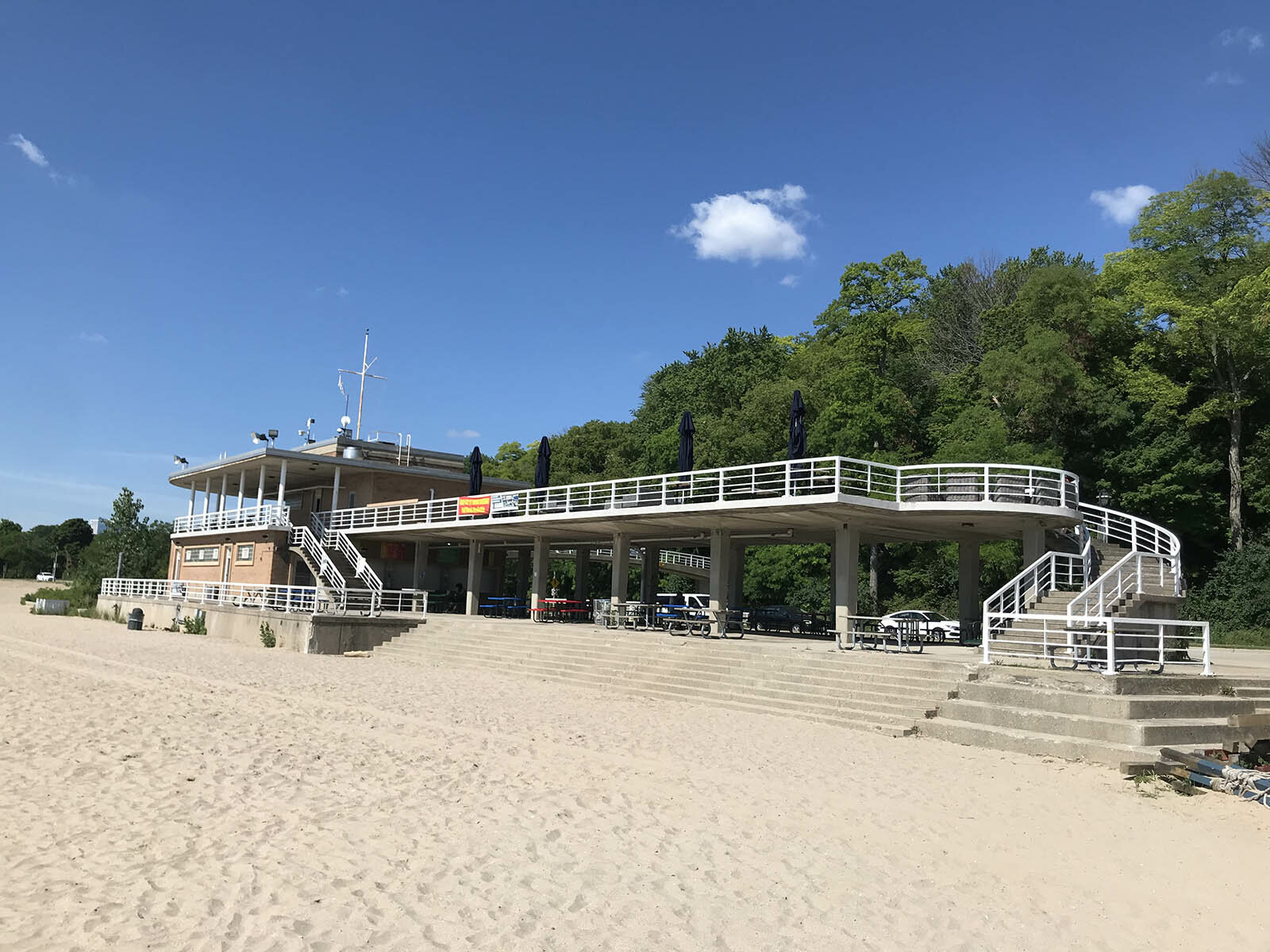{image1} Researchers looking for the cause of pollution responsible for closing Milwaukee's Bradford Beach in the spring and summer of 2004 have identified one ironic leading contributor to the contamination:
Milwaukee County government itself, just-revealed documents and scientific findings show.
Contamination is reaching the Bradford Beach sand and water through five large sewer pipe openings known as "outfalls," which are owned by Milwaukee County. Topped with circular, protective concrete covers about five feet in diameter, the outfalls are located at the top of Bradford Beach and east of the Lincoln Memorial Drive sidewalk closest to a part of the lakeshore described on the county parks' Web site as "Milwaukee's most popular beach for swimming and sunbathing."
There are outfalls near both the north and south sides of the main gathering spot at the Bradford Beach bathhouse. Frequently used sand volleyball courts and sunning areas are also close to outfalls, as are wading and swimming spots.
Though beach closings and Lake Michigan's water quality have been widely covered in the news media, the possible contributing role played by Milwaukee County-owned sewer outfalls hasn't been part of the public discussion. It has, however, been known to academics and government officials.
The county's sewer outfalls have long been located at the beach, according to Greg High, an administrator with the County Department of Parks and Public Infrastructure.
High said that during rainstorms, storm water takes various paths before emptying into Lake Michigan through the Bradford Beach outfalls. He said water runs down the Lake Park bluffs, off parkland west of Lincoln Memorial Drive, and across the roadway before emerging through the outfalls.
But because of the outfalls' locations -- and because of how rainwater becomes polluted -- the outfalls spew contaminated water directly across this premier sandy beach and into Lake Michigan water, according to scientists at the University of Wisconsin-Milwaukee's Great Lakes Wisconsin Aquatic Technology and Environmental Research Institute.
The WATER Institute's researchers have been taking water samples and tracing E. coli bacteria contamination since 2003 and are working with several units of government, including the county, to identify pollution sources and reduce contamination. They have discovered that the county pipes are contaminating Bradford Beach.
"We have found the one major source of contamination, if not the primary source, is the storm water discharged from outfalls above the beach area," said institute assistant scientist Sandra L. McLellan, in a Sept. 3, 2004 memo to the City of Milwaukee budget office.
The water institute, partnering with the city's Health Department and county government, has documented how quickly and severely the outfalls put dangerous contamination onto Bradford Beach, records show.
Within one hour of a June 2004 rainstorm, levels of the bacteria E. coli, a health hazard found in feces, had jumped at Bradford Beach to more than 67 times the level above which the U.S. Environmental Protection Agency says makes for unsafe swimming, McLellan wrote.
"The spatial distribution of the E. coli across the beach matches the path the outfall water runs before it drains to Lake Michigan," McLellan wrote. "The water from the outfall cuts a path across the sand, in the area where children play, before it enters Lake Michigan. Therefore, even though water quality advisories are issued, the beach area itself may be a health concern.''
E. coli can live in the sand; when it reaches colder water beyond the swimming beach, E. coli dies.
The institute's Web site contained this description of how rainwater can turn into such a pollutant:
"Water that enters storm drains is not 'treated' before it empties into a stream, river or lake. This means that when it rains, oil, antifreeze, paint, grass clippings, household waste, pet waste and any other debris on our streets and sidewalks flows directly into our nearby surface waters," says the description.
High, of the county's parks and infrastructure department, said the county was using the institute's findings and other means to help "backtrack" and find potential E. coli sources in Lake Park. He said those sources could include sanitary sewage infiltration, pet and wild animal waste, gull droppings and the possible leakage into the storm sewers of human fecal matter from county toilets in parks buildings.
He said more data would be collected to pinpoint how and where the E. coli might be originating, adding that re-routing or relocating the outfalls were possible solutions to the beach contamination problem.
McLellan said, "It isn't good management practice to have storm outfalls so near to a recreational area."
Testing of Lake Michigan water and the cleaning and closing the beaches in Milwaukee is a shared responsibility.
The UWM institute uses state and federal grant funds to find sources of Lake Michigan water pollution. McLellan said water sampling and pollution research was ongoing up and down the Lake Michigan shoreline. In Milwaukee, she said, gull droppings and sewerage infiltration into storm water were eyed as possible beach pollution contributors.
The City of Milwaukee Health Department conducts daily tests of beach water during the summer, and depending on pollution levels, issues swimming advisories and beach closing recommendations. The county is in charge of closing beaches because they are part of the county-run parks system.
In a three-month period from May 5 to Aug. 4 of last year, E. coli contamination in the water at Bradford Beach was deemed unacceptable for swimming 44 percent of the time -- nearly double the rate in 2003 -- according to the city Health Department.
Officials at the Milwaukee Metropolitan Sewage District, the region's sewerage treatment agency, have pointed to cutbacks in county parks' budgets and the location of the outfalls at Bradford Beach in particular as contributors to beach and water degradation along the lakeshore.
"Bradford Beach suffers from poor maintenance," said Kevin Shafer, MMSD's executive director, in an Oct. 29, 2004 report to the district's commissioners. The report recommended a $25,000 MMSD expenditure for a Bradford Beach demonstration improvement project in 2005.
A spot check of the Lake Park hillside, the beach and two parking lots next to and across the road from Bradford Beach in late December bore out Shafer's assessment. All surfaces contained a variety of fast food wrappers, soda and beer cans, pet waste, newspapers and plastic and paper bags. Despite signs forbidding dogs, three people were allowing their dogs to run off-leash on the sand.
MMSD approved the expenditure in its 2005 budget and plans to meet with county officials in February to coordinate the spending.
Shafer's report said MMSD proposed the project because "the cleanliness and general upkeep of the beaches has suffered due to cuts to the Milwaukee County Parks Department budget, negatively impacting water."
The MMSD addressed county budget cutbacks with grants in 2003 and 2004 to pay for the removal from Bradford Beach of algae that acts as a food source for bacteria, Shafer's report said.
The report recommends that the county improve its beach combing and algae removal techniques to help lower the bacteria counts. It also calls for the creation of a "strong public education effort" about the sources of beach contamination and the implementation of "testing best management practices at one of the storm sewer outfalls."
"Milwaukee County should take actions that would have an immediate, cost-effective benefit on water quality near beaches," Shafer wrote.
Shafer pointed to an earlier joint effort among MMSD, the UWM WATER Institute and Milwaukee County to reduce pollution at South Shore Beach. Shafer also said progress could be made at Bradford Beach by copying beach grading and "innovative" cleanup techniques at Racine's beaches.
McLellan's Sept. 3 memo to the city budget office did not mince words about the how the contamination was getting onto Bradford Beach, and about its dangers.
"We have found that the source of the E. coli is primarily from the E. coli burden in the sand and from five outfalls," she wrote.
In italics, she added: "Any sanitary inputs into the storm water system presents a serious health risk to citizens using the beach."
Rowen is a veteran journalist in Milwaukee who writes and consults on environmental and political issues.
The opinions expressed in this column do not necessarily reflect the opinions of OnMilwaukee.com, its advertisers or editorial staff.
 |
Sign up now for a free e-mail election service from WisPolitics.com. Click here. |







